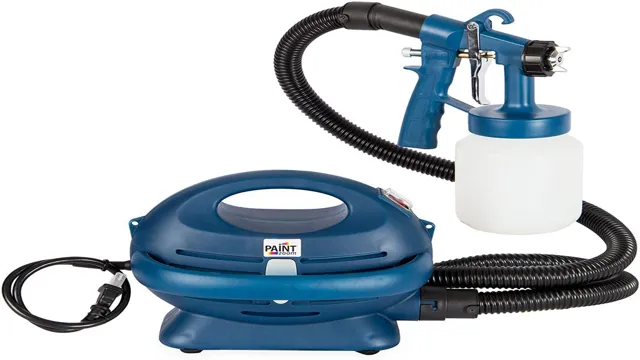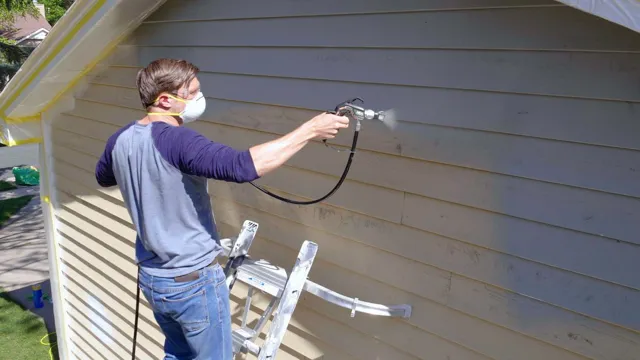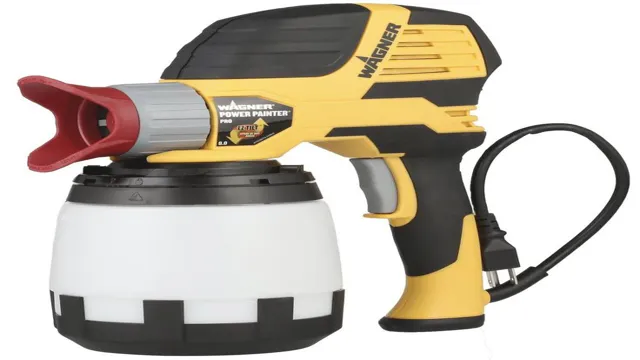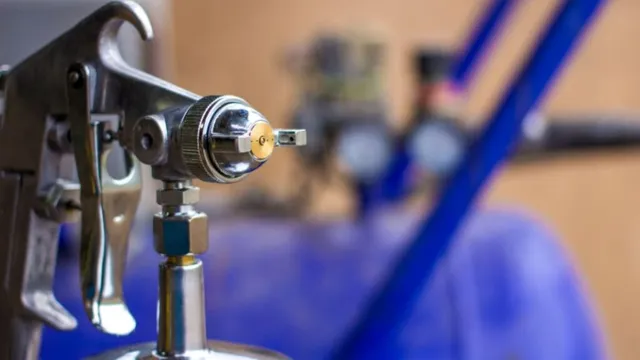Can You Use a Paint Sprayer for Interior Walls? Pros and Cons Explained

If you’re considering remodeling or redecorating your home, painting your walls is a simple, effective and inexpensive way to give your interior an instant boost. But with so many options available, choosing the right painting technique can be overwhelming. That’s where using a paint sprayer for interior walls comes in.
Paint sprayers might seem like intimidating tools, but in reality, they’re easy to use and provide a smooth and uniform finish that roller and brush painting can’t match. Moreover, they’re faster and allow you to cover large areas in significantly less time, reducing the amount of prep and cleanup work required. So, if you want to save time and effort, and achieve professional-quality results, a paint sprayer is worth considering.
In this blog post, we’ll cover the ins and outs of using a paint sprayer for interior walls, from equipment selection and preparation to tips and tricks on achieving a flawless finish. Whether you’re a DIY enthusiast looking to take your painting game to the next level or a professional painter seeking to improve your efficiency and quality, you’ll find valuable insights and guidance here. So, let’s dive in and start painting!
Benefits of Using a Paint Sprayer
Yes, you can definitely use a paint sprayer for interior walls. In fact, using a paint sprayer for painting your interior walls offers several benefits. Firstly, it saves you a significant amount of time and effort compared to using traditional painting methods.
With a paint sprayer, you can cover large areas in a short amount of time, and the paint sprays evenly without leaving any brush marks or streaks. This results in a smooth and seamless finish that looks professional and polished. Additionally, a paint sprayer allows you to control the amount of paint you are distributing, which means you can achieve a more even coverage and reduce the risk of drips and splatters.
Moreover, paint sprayers are versatile tools that can work with a variety of paints, including latex, enamels, and stains. This makes them a great choice for any home renovation or painting project. So, if you are looking for a faster, more efficient, and more precise way to paint your interior walls, using a paint sprayer is definitely worth considering.
Save Time and Effort
If you’re a DIY enthusiast who loves to spruce up their living space but hates the tedious task of painting walls, then a paint sprayer is the perfect tool for you. Not only does it save you time and effort but also provides a smoother and more even finish than traditional brush painting. Using a paint sprayer means you can cover large areas quickly, and it’s easy to get into tight corners and angled surfaces without leaving brush marks.
This tool is perfect for painting walls, ceilings, furniture, fences, and even cars. Plus, you can use it to paint different types of surfaces such as wood, metal, and plastic. The best part is that you don’t need to be a professional painter to use a paint sprayer as they’re user-friendly and provide better results than traditional painting methods.
So next time you have a painting project, try a paint sprayer and see the difference for yourself. Your painted surfaces will look more professional and have a smooth, even finish that will last for years to come.

Achieve a Smooth, Professional Finish
If you want a smooth and professional finish for your painting project, using a paint sprayer can provide numerous benefits. Unlike traditional painting methods, paint sprayers help you achieve a uniform and consistent coat that covers every inch of the surface with ease. This means you’ll save time and effort while still getting an excellent result.
With paint sprayers, you can also choose the right spray pattern for your project, whether that’s a narrow spray for edges or a wide spray for large walls. One of the most significant advantages of using a paint sprayer is that it eliminates brush and roller marks, leaving your walls looking flawless. Additionally, paint sprayers allow you to control the amount of paint sprayed, saving you money and reducing waste.
Overall, using a paint sprayer is a smart investment, making painting quicker, easier, and more efficient, and providing better, long-lasting results that will enhance the overall look of your space.
Reach Difficult Areas Easily
Using a paint sprayer can provide numerous benefits, particularly when it comes to reaching difficult areas. Traditional brushes and rollers can be a struggle to use in tight or hard-to-reach spaces, but with a paint sprayer, you can easily cover these areas without much effort. Additionally, paint sprayers provide a more even and consistent application, ensuring your surfaces are covered thoroughly and look professional.
They are also a time-saver, allowing you to finish your painting projects much faster than with traditional methods. Overall, the convenience and effectiveness of using a paint sprayer make it a valuable tool for any DIY enthusiast or professional painter.
Types of Paint Sprayers for Interior Walls
Yes, paint sprayers can be great for interior wall painting. There are several types of paint sprayers you can use depending on your needs, budget, and level of expertise. HVLP (High Volume Low Pressure) sprayers are perfect for beginners as they are easy to use and are less likely to cause overspray while still providing an excellent finish.
Airless sprayers, on the other hand, are better suited for larger areas as they can cover large areas quickly and efficiently. If you are looking for a professional-grade sprayer, consider investing in an airless sprayer. They offer more power and versatility for heavy-duty projects.
However, they require more skill and experience to operate. Regardless of which type you choose, using a paint sprayer for interior walls will save you time and effort compared to using a traditional roller or brush. So, go ahead and take advantage of the convenience of using a paint sprayer while achieving a perfect finish on your walls.
Airless Paint Sprayers
When it comes to painting interior walls, there are a few types of paint sprayers to consider. One of the most popular options is the airless paint sprayer, which uses high pressure to atomize the paint and propel it onto the surface. This method provides a quick and even coverage, making it perfect for large projects or when working with textured surfaces.
Another option is the HVLP spray gun, which uses a high volume of air to spray the paint in a fine mist. This allows for more control over the application and is great for detailed work. The third option is the handheld paint sprayer, which is compact and easy to maneuver, making it ideal for smaller projects or touch-ups.
Whichever type of paint sprayer you choose, make sure to follow the manufacturer’s instructions and take proper safety precautions, such as wearing a mask and protective eyewear. With the right tools and techniques, you can achieve professional-quality results in no time.
HVLP Paint Sprayers
When it comes to painting interior walls, there are several types of paint sprayers to choose from, with HVLP (high-volume, low-pressure) being one of the most popular. HVLP paint sprayers are great for use in small and medium-sized projects. They work by atomizing paint using a high volume of air at low pressure, resulting in a fine and precise spray pattern.
This type of sprayer provides a smooth and even finish without wasting a lot of paint. Another benefit of HVLP sprayers is that they are easy to clean, making them a favorite for DIY enthusiasts. Overall, HVLP paint sprayers are ideal for those who want to achieve a professional-looking paint job without hiring a professional.
Compressed Air Paint Sprayers
When it comes to painting interior walls, there are a few different types of paint sprayers you may consider using. One option is the compressed air paint sprayer, which uses compressed air to atomize the paint and create a fine mist that evenly coats the surface. This type of sprayer is known for its versatility, as it can be used with a wide range of paint types and viscosities.
However, it can also be messy and may require more preparation and cleanup than other types of sprayers. Another option is the airless paint sprayer, which uses high pressure to force the paint through a small nozzle and onto the surface. This type of sprayer is ideal for large, flat surfaces and can cover a lot of area quickly.
However, it may not work well with thicker paints and can create more overspray than other types of sprayers. Ultimately, the type of paint sprayer you choose will depend on your specific needs and preferences.
Tips for Using a Paint Sprayer for Interior Walls
Yes, you can use a paint sprayer for interior walls, and it can save you a lot of time and energy compared to using a roller or brush. However, there are some tips you should follow to ensure your paint job comes out smooth and even. First, make sure to cover all surfaces and furniture nearby with drop cloths to protect them from overspray.
It’s also important to practice on a test surface before starting on the walls to get comfortable with the sprayer and find the right pressure and nozzle size. When spraying the walls, move in a controlled, consistent motion and overlap each pass slightly to avoid streaks and gaps. It’s also a good idea to focus on one section at a time and work from top to bottom.
With a little practice and patience, using a paint sprayer can be a game-changer for your interior painting projects.
Preparation is Key
When it comes to painting the interior walls of your home, preparation is key to achieving a professional look. The first step is to choose a paint sprayer that suits your needs and experience level. Next, ensure that the room is well-ventilated and that all furniture and fixtures are covered or moved out of the way.
Sanding the walls and filling in any cracks or holes is also essential to achieving a smooth finish. And don’t forget to tape off all surfaces that you don’t want to be painted, such as trim or window frames. By taking the time to properly prepare the space and your tools, you’ll be on your way to a successful and stress-free painting experience.
Practice on a Test Surface
If you’re planning to use a paint sprayer to paint the interior walls of your house, there are some useful tips that will help make the process smoother. One important tip is to practice on a test surface before you start the actual painting. This is especially important if you’re not familiar with paint sprayers, as it will help you get a sense of how the sprayer works and how the paint comes out of it.
You can practice on a piece of cardboard or a spare piece of drywall that you have lying around. This will also give you the opportunity to adjust the sprayer’s settings, such as the spray pattern and pressure, to ensure that the paint is coming out the way you want it to. By doing this, you’ll be able to avoid mistakes and be more confident when you start painting the actual walls.
Watch Your Speed and Pressure
When using a paint sprayer for interior walls, it’s important to pay close attention to your speed and pressure. While it may be tempting to rush through the job to get it done quickly, going too fast can result in an uneven application and drips. On the other hand, using too much pressure can cause overspray and a messier work area.
So, what’s the sweet spot for speed and pressure? It may take some trial and error to find what works best for you, but generally, a moderate speed and light pressure will result in a smooth and even coat of paint. Remember to keep the sprayer at a consistent distance from the wall and move it in a steady back-and-forth motion for the best results. By taking your time and finding the right speed and pressure, you can achieve a professional-looking paint job that will last for years to come.
Conclusion
In conclusion, using a paint sprayer for interior walls is like using a laser pointer instead of a flashlight to find your way in a dark room. Sure, it may be faster and more efficient, but it requires a steady hand and a keen eye to avoid making a mess. Ultimately, the choice to use a paint sprayer or a roller depends on your level of experience and preference.
Just remember to cover everything you don’t want painted and wear a mask to avoid inhaling paint fumes!”
FAQs
1. What is a paint sprayer and how does it work for interior walls?
A paint sprayer is a tool which sprays paint onto a surface using compressed air or high pressure. It uses less time and energy than traditional paintbrushes and rollers, making it ideal for covering large surfaces quickly.
2. What are the advantages of using a paint sprayer for interior walls?
Using a paint sprayer for interior walls provides a smooth and even finish, requires less physical effort than traditional painting methods, and can save both time and money.
3. Can a paint sprayer be used for all types of interior walls, including textured surfaces?
Yes, a paint sprayer can be used on most types of interior walls, including textured surfaces. However, it is important to choose the right type of sprayer and nozzle to ensure that the paint is evenly distributed and adheres properly to the surface.
4. Do you need any special skills or training to use a paint sprayer for interior walls?
While using a paint sprayer for interior walls does not require any special skills or training, it is important to follow the manufacturer’s instructions and take appropriate safety precautions. It may be helpful to practice on a small area or piece of scrap material before starting your project.
5. What types of paint can be used with a paint sprayer for interior walls?
Most types of paint can be used with a paint sprayer, including latex, oil, and even stains. However, it is important to read the manufacturer’s recommendations for your specific sprayer and paint type.
6. How do I prepare my interior walls before using a paint sprayer?
Before using a paint sprayer on your interior walls, you should clean the surfaces with soap and water, remove any loose or peeling paint, patch any holes or cracks, and apply primer if needed. It is also important to protect the surrounding area with plastic sheeting and masking tape.
7. Can a paint sprayer be used to paint ceilings?
Yes, a paint sprayer can be used to paint ceilings as well as walls. However, it may require additional equipment or attachments depending on the height and angle of the ceiling. It is important to follow safety guidelines and wear appropriate gear when painting ceilings with a sprayer.



